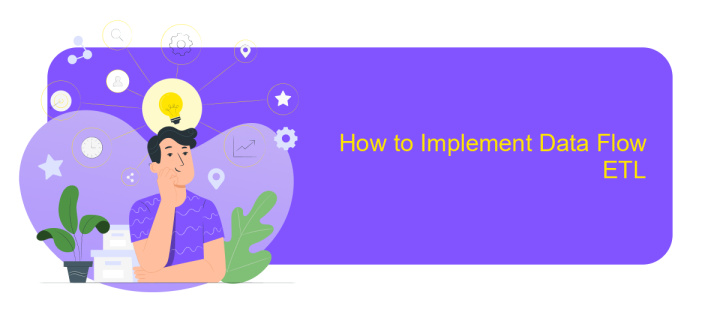Data Flow ETL
Data Flow ETL (Extract, Transform, Load) is a critical process in data management and analytics. It involves extracting data from various sources, transforming it into a suitable format, and loading it into a target system for analysis and reporting. This article delves into the intricacies of Data Flow ETL, highlighting its importance, methodologies, and best practices for efficient data processing.
Introduction
Data Flow ETL (Extract, Transform, Load) is a fundamental process in data management and analytics. It involves extracting data from various sources, transforming it into a suitable format, and loading it into a target database or data warehouse. This process ensures that data is accurate, consistent, and readily available for analysis and decision-making.
- Extraction: Gathering data from multiple sources, such as databases, APIs, and flat files.
- Transformation: Cleaning, enriching, and converting data into a usable format.
- Loading: Inserting the transformed data into a target system for further use.
Modern ETL tools and services, like ApiX-Drive, simplify the integration process by providing a user-friendly interface for connecting various data sources and automating workflows. ApiX-Drive allows businesses to seamlessly integrate applications and automate data transfer without extensive coding, making it an invaluable asset in the ETL process.
What is Data Flow ETL?

Data Flow ETL (Extract, Transform, Load) is a process that involves extracting data from various sources, transforming it to fit operational needs, and loading it into a target database or data warehouse. This method is crucial for integrating and consolidating data from disparate systems, thereby enabling comprehensive data analysis and reporting. The ETL process ensures that data is accurate, consistent, and ready for use in business intelligence and analytics applications.
Modern ETL processes are often automated using integration services such as ApiX-Drive, which simplifies the setup and management of data flows. ApiX-Drive allows users to connect different applications and data sources without requiring extensive coding knowledge. By streamlining the integration process, services like ApiX-Drive enable businesses to maintain seamless and efficient data operations, ultimately supporting better decision-making and strategic planning.
The Benefits of Data Flow ETL

Data Flow ETL (Extract, Transform, Load) is a powerful methodology for managing data in a seamless and efficient manner. It enables organizations to consolidate data from various sources, ensuring it is clean, consistent, and ready for analysis. This approach supports real-time data processing and helps in making informed business decisions.
- Improved Data Quality: By automating data extraction and transformation, Data Flow ETL reduces human errors and ensures that the data is accurate and reliable.
- Scalability: Data Flow ETL systems can handle large volumes of data, making it easy to scale operations as the organization grows.
- Cost Efficiency: Automating the ETL process reduces the need for manual intervention, saving both time and resources.
- Integration Capabilities: Tools like ApiX-Drive facilitate seamless integration between different data sources and systems, further enhancing the efficiency of the ETL process.
- Enhanced Decision-Making: With real-time data processing, organizations can make timely and informed decisions, driving better business outcomes.
Incorporating Data Flow ETL into your data management strategy can significantly enhance operational efficiency and data quality. Leveraging services like ApiX-Drive can further streamline the integration process, making it easier to connect various data sources and automate workflows. Ultimately, this leads to more accurate insights and better-informed business decisions.
How to Implement Data Flow ETL

Implementing Data Flow ETL involves several critical steps to ensure seamless data extraction, transformation, and loading. First, identify the data sources that need to be integrated, which could include databases, APIs, or flat files. Understanding the structure and format of these sources is crucial for effective data extraction.
Next, design the transformation logic that will convert the raw data into a format suitable for analysis or storage. This may involve data cleaning, normalization, and enrichment processes. Tools like Apache NiFi or Talend can be useful for managing these transformations efficiently.
- Identify data sources
- Design transformation logic
- Select ETL tools
- Configure data loading
- Monitor and maintain the ETL pipeline
Finally, load the transformed data into the target storage system, which could be a data warehouse, data lake, or another database. Services like ApiX-Drive can facilitate the integration of various data sources and automate the ETL process, ensuring that data flows smoothly and reliably across your systems.
Conclusion
In conclusion, Data Flow ETL is a transformative approach that streamlines the process of extracting, transforming, and loading data. By enabling seamless data integration and providing real-time data processing, organizations can make more informed decisions and enhance operational efficiency. The ability to automate workflows and reduce manual intervention not only saves time but also minimizes errors, ensuring data accuracy and reliability.
Moreover, leveraging tools like ApiX-Drive can significantly simplify the integration process. ApiX-Drive offers a user-friendly platform that allows businesses to connect various applications and automate data transfers without the need for extensive coding knowledge. This empowers organizations to focus on their core activities while ensuring their data flow remains uninterrupted and efficient. Overall, the adoption of Data Flow ETL, supported by robust integration services, is crucial for businesses aiming to stay competitive in today’s data-driven landscape.
FAQ
What is ETL in the context of data flow?
Why is ETL important for businesses?
What are the common challenges associated with ETL processes?
How can ETL processes be automated?
What should be considered when choosing an ETL tool?
Routine tasks take a lot of time from employees? Do they burn out, do not have enough working day for the main duties and important things? Do you understand that the only way out of this situation in modern realities is automation? Try Apix-Drive for free and make sure that the online connector in 5 minutes of setting up integration will remove a significant part of the routine from your life and free up time for you and your employees.

